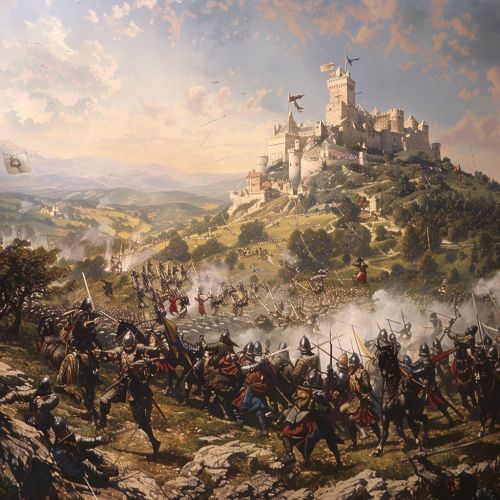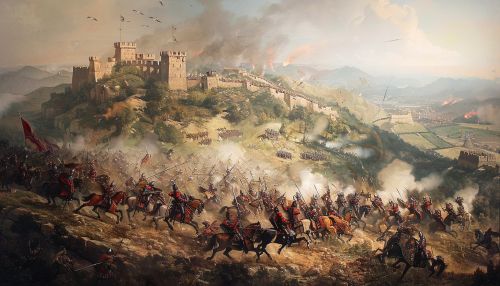Battle of White Mountain: Difference between revisions
(Created page with "== Background == The '''Battle of White Mountain''' (Czech: ''Bitva na Bílé hoře''; German: ''Schlacht am Weißen Berg'') was a pivotal conflict fought on November 8, 1620, near Prague, in the early stages of the Thirty Years' War. This battle marked a significant turning point in the war, leading to the defeat of the Bohemian Protestant forces by the Catholic League and the Imperial Army. The battle's outcome had profound implications for the religious and polit...") |
No edit summary |
||
| Line 21: | Line 21: | ||
The battlefield was located on a plateau near the White Mountain, approximately 8 kilometers west of Prague. The Bohemian army took a defensive position on the high ground, hoping to leverage their advantageous terrain. However, their forces were stretched thin, and their defensive preparations were inadequate. | The battlefield was located on a plateau near the White Mountain, approximately 8 kilometers west of Prague. The Bohemian army took a defensive position on the high ground, hoping to leverage their advantageous terrain. However, their forces were stretched thin, and their defensive preparations were inadequate. | ||
[[Image:Detail-92389.jpg|thumb|center|Depiction of soldiers fighting on a hilly terrain with a castle in the background.|class=only_on_mobile]] | |||
[[Image:Detail-92390.jpg|thumb|center|Depiction of soldiers fighting on a hilly terrain with a castle in the background.|class=only_on_desktop]] | |||
The Catholic forces, on the other hand, were well-coordinated and employed a disciplined approach. Tilly and Bucquoy decided to launch a direct assault on the Bohemian positions, aiming to break their lines quickly and decisively. | The Catholic forces, on the other hand, were well-coordinated and employed a disciplined approach. Tilly and Bucquoy decided to launch a direct assault on the Bohemian positions, aiming to break their lines quickly and decisively. | ||
Latest revision as of 23:39, 14 June 2024
Background
The Battle of White Mountain (Czech: Bitva na Bílé hoře; German: Schlacht am Weißen Berg) was a pivotal conflict fought on November 8, 1620, near Prague, in the early stages of the Thirty Years' War. This battle marked a significant turning point in the war, leading to the defeat of the Bohemian Protestant forces by the Catholic League and the Imperial Army. The battle's outcome had profound implications for the religious and political landscape of Central Europe.
Prelude to the Battle
Political and Religious Context
The Thirty Years' War was a complex conflict driven by a mix of religious, political, and territorial disputes. The Holy Roman Empire was a fragmented entity with numerous semi-autonomous states, each with its own ruler and religious affiliations. The Peace of Augsburg (1555) had established the principle of cuius regio, eius religio, allowing rulers to determine the religion of their own territories. However, tensions between Protestant and Catholic states remained high.
The Bohemian Revolt (1618-1620) was a significant precursor to the Battle of White Mountain. The revolt began when Protestant nobles in Bohemia, unhappy with the Catholic Habsburg rule, threw two imperial officials out of a window in an event known as the Defenestration of Prague. This act of defiance led to the election of Frederick V of the Palatinate, a Protestant, as King of Bohemia, challenging the authority of the Catholic Emperor Ferdinand II.
Military Preparations
The Bohemian forces, led by Christian of Anhalt, were composed of a mix of local troops and mercenaries. They faced the combined forces of the Catholic League, commanded by Johann Tserclaes, Count of Tilly, and the Imperial Army under the command of Charles Bonaventure de Longueval, Count of Bucquoy. The Catholic forces were better organized and more experienced, giving them a significant advantage.
The Battle
Deployment and Strategy
The battlefield was located on a plateau near the White Mountain, approximately 8 kilometers west of Prague. The Bohemian army took a defensive position on the high ground, hoping to leverage their advantageous terrain. However, their forces were stretched thin, and their defensive preparations were inadequate.


The Catholic forces, on the other hand, were well-coordinated and employed a disciplined approach. Tilly and Bucquoy decided to launch a direct assault on the Bohemian positions, aiming to break their lines quickly and decisively.
The Course of the Battle
The battle commenced in the early morning hours of November 8, 1620. The Catholic forces advanced in a coordinated attack, with infantry and cavalry units working in tandem. The Bohemian defenders, despite their advantageous position, were unable to withstand the disciplined assault.
The Bohemian left flank, commanded by Heinrich Matthias von Thurn, was the first to crumble under the pressure. As the Catholic forces pushed forward, the Bohemian center and right flanks also began to falter. The battle quickly turned into a rout, with the Bohemian forces fleeing the field in disarray.
The entire engagement lasted only about two hours, highlighting the overwhelming superiority of the Catholic forces. The Bohemian army suffered heavy casualties, and many of their leaders were captured or killed.
Aftermath
Political Consequences
The defeat at White Mountain had immediate and far-reaching consequences for Bohemia and the broader Holy Roman Empire. Frederick V, known as the "Winter King" due to his short reign, fled into exile, and the Habsburgs reasserted their control over Bohemia. The Catholic victory led to a harsh retribution against the Protestant nobility, with many being executed or forced into exile.
The battle also marked the beginning of a period of intense Counter-Reformation efforts in Bohemia. The Habsburgs implemented policies aimed at re-Catholicizing the region, including the suppression of Protestant practices and the promotion of Catholic education and institutions.
Military Implications
The Battle of White Mountain demonstrated the effectiveness of the Catholic League's military organization and strategy. The victory bolstered the confidence of the Catholic forces and set the stage for further successes in the early years of the Thirty Years' War.
The battle also highlighted the challenges faced by the Protestant forces, including issues of coordination, leadership, and resources. The defeat weakened the Protestant cause in the Holy Roman Empire and contributed to the fragmentation and internal conflicts that would plague the Protestant states throughout the war.
Legacy
The Battle of White Mountain remains a significant event in European history, symbolizing the triumph of the Counter-Reformation in Central Europe. The battle's outcome reinforced the power of the Habsburgs and the Catholic Church, shaping the religious and political landscape of the region for centuries to come.
The site of the battle, located near the modern-day city of Prague, is commemorated by various monuments and memorials. The battle is also a subject of historical research and analysis, with scholars examining its causes, course, and consequences in the broader context of the Thirty Years' War.
